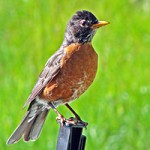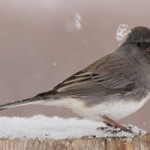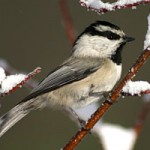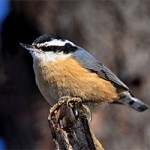The days are getting longer and the temperatures a bit warmer. With summer around the corner, daybreak is alive with bird songs. As the summer progresses the forest and bird feeders come alive with songbirds. Your kids will notice, and this natural phenomena provides a perfect opportunity to make the natural world into a classroom without walls.
What about spring makes the birds start singing?
All animals have biological clocks driven by the changes in season. It’s why bears hibernate, whales migrate across oceans and why outdoorsy people shed pants and boots for shorts and flip flops. Increasing hours of daylight stimulate a hormonal reaction in male birds’ brains. This reaction tells them to start singing and find a mate! Most species of Passerines, or songbirds have a song that is unique to their species. With a little patience it’s possible to quickly identify birds by their songs and calls.
How do I pick out various songs?
Even as a novice, we can identify songs of birds that are common to where we live. Many birders put a mnemonic to the song to make it easier to remember. For instance, the Mountain Chickadee has a three syllable call that sounds a lot like the word “cheese burger.” Saying the mnemonic as you listen to the song helps you get the rhythm and pitch and makes it easier to identify when you’re outside. When it comes to identifying by sight, start with the color and then note the color of the wings, breast, neck and beak. Try to remember those details until you can get back to your home library.
Here are some basic birds.
American Robin – Generally ubiquitous across U. S., the Robin, in the thrush family, is easily identified by its red breast. The Robin sings “Churlee-churloo, churlee-churloo, churlee-churloo.”
Dark-eyed Junco – Commonly found in parks or the suburbs in the winter and early spring, the Dark-eyed Junco is a frequent visitor to bird feeders. Coloration varies across the U. S., but a dark colored head (almost like a hood in some sub-species) that contrasts with a light colored belly and pinkish bill. The Junco’s song is a musical trill, with individual notes almost indistinguishable. Mnemonics vary but I think it sounds like a metal chain being pulled slowly off of a spool.
Chickadee — A small bird, often seen in flocks, chickadees hang from the tips of tree branches as they feed. There are actually four species spread across the country. To identify, look for a dark cap and throat with a white stripe near the eye. While their calls differ in tone or pitch, chickadees are name sayers, “Chick-a-dee-dee-dee.” Check out the species accounts for Black-capped Chickadees, Carolina Chickadees, Chestnut-backed Chickadees and Mountain Chickadees to find the call/song of the species near you! If you’re hungry in the mountains try to ignore the Mountain Chickadee, which sings “Cheeeese- burger.” You and your kids will start to hear them every where.
Red-breasted Nuthatch – While you may rarely see the Red-breasted Nuthatch in western and northern coniferous forests, they are often heard singing year round. Likened to a toy horn, the Red-breasted Nuthatch nasally sings “Aunk, aunk, aunk, aunk.”
Mastered those already? Check out the Cornell Lab of Ornithology’s website that has information and photos for most U. S. species of birds as well as sound clips.
Are there organized activities to help my family learn?
The National Audubon Society has chapters in every state! Find your local chapter for information on birds in the area and fun birding walks that are geared towards any age and skill level (resources vary by chapter). When in doubt, just give thema call. They love to help.
Check out a used book store. More often than not there is an old Peterson’s Field Guide that is a great resource filled with color drawings that you can use to help your kids identify various species. Many birders have life lists where they record species they hear or see. You can record all the birds you’ve seen in a diary or in the back of your field guide. Once your kids get in the habit of listening, they will begin to pick up on new species when you travel or the birds migrate through in the spring and fall.





Now I know the bird that sounds like the mile alarm on our GPS watch – the dark-eyed junco. Thanks!
Oops, hit submit too early. Here’s a website I found that has short clips of a whole bunch of bird songs and calls.
http://www.enature.com/birding/audio.asp
A fun (and funny) way to introduce kids to birding is to play “Name That Bird!”
This activity will help them learn what to look for once they have these fantastic songbirds in their sights so they can identify them later. Plus it is a great game to play to distract the little ones while someone else cooks dinner.
Gather up some colorful outer (or under) wear; hide behind the tent/tree and don your unique crown, throat, wings, tail, back/rump, breast, legs, etc.; then–with your most authentic bird call (mine seems to always sound like an arceopteryx)–leap out and give your little observers ten (or fifteen) seconds to see as many of the different “markings” as they can. Then, hop/flap/flitter/flutter back to your hiding place and see how many they can remember. They can draw/write down/list those characteristics…and whoever remembers the most gets to be the next bird.
It helps kids realize that the “slow” pace of birding actually has moments of high drama when you are trying to mentally “capture” the bird before it flutters off. This drama can be especially heightened for parents when you are trying to get the four year old to use both eyes to aim and then look through the binoculars at the first bluebird of the spring…and all he wants to do is look back and see if he can still see the mushed grasshopper that was being eaten by ants three switchbacks ago.
You gotta start somewhere. Have fun!
Ariella, I love this activity . . . and speaking as someone who has introduced birding to high school students, I would bet that this will work exceptionally well with older “little ones,” too. Thanks for sharing!
Also, for anyone interested, in terms of learning bird songs there is no better resource than the Peterson “Birding by Ear” cd’s. This series walks you through groups of similar-sounding songs, taking care to fully describe the relevant “markings” that distinguish one bird’s distinct song from another. This is NOT the same thing as an audio field guide to bird songs. The latter is a good reference for experienced birders, but the former is much more like taking a class with an excellent instructor.